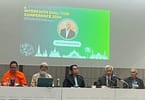Despite the on-going economic crisis, ITB Asia has confirmed its positioning as a major trade show for the travel trade. Some 680 companies from 60 countries were exhibiting at this second edition. Last year, ITB Asia management was confident to reach 720 exhibitors. The target was not reached but worldwide economic recession made this target unsustainable. “This year, I am happy to say that ITB Asia has broadly maintained its size,” declared Raimund Hosch, CEO of Messe Berlin, the show organizer.
Although some countries decided not to be present this year –such as Mexico or Scandinavian countries- ITB Asia saw a flow of new destinations present for the first time such as Japan (through JNTO) or Sharjah. Some countries had also a significantly larger presence such as Indonesia, Thailand or India.
The difficulty for ITB Asia is to find its right positioning in a time where travel shows succeed to travel shows. Squeezed between PATA Travel Mart –probably ITB most serious competitor-, IT&CMA, two travel shows in Indonesia as well as WTM in London, ITB Asia plays consequently on the fact that it must be a true travel mart where SME and Asia companies come to look at products and eventually contract. In harsh economic times, ITB Asia perfectly cover the need for those companies which have limited budget to visit ITB in Berlin in march. Coming from Singapore is also cost-savvy in hotel and air tickets prices for Asian buyers.
“For me, this show has brought many positive outcome with a wide range of information on products and prices,” says Suraj Khan, working for Eco ventures, an India-based travel agency looking at community and eco-tourism. “Last year, we had a majority of enquiries from Indonesia. This year we saw more Chinese and Singaporeans looking to program our country,” tells Mahroon, Assistant General Manager for Oman Tourism Board.
ITB Singapore can then act as the perfect pendant to ITB Berlin in Asia. The show seems to turn into a major plat-form to meet especially Indian and South Asia buyers. According to data, 56% of all buyers were from Asia but India had the largest number of travel agencies present with 59 companies. More disappointing is however china’s absence. Except Shanghai promoting itself within a new marketing cooperation with Pusan and Osaka dubbed the “Golden Triangle”, they were neither exhibitors from the Mainland, nor from Macau or Hong Kong. And only five buyers from Mainland China were officially recorded.
Some rumors coming from buyers and sellers explain China’s low attendance by a de facto boycott conducted by China, as Beijing was competing against Singapore to host the show. However, according to Dr Martin Buck, CEO of Messe Berlin in Singapore, ITB Asia has put during its first two years more emphasis on Southeast Asia and South Asia. “We have started well with both regions. We
now have China and Northeast Asia firmly in our sights. We can expect to see a respectable upturn in the number of exhibitors from China next year,” he explains. For Murray Bayley, chief editor of the newsletter Travel Business Analyst and a specialist of Asian markets, “if there is really a boycott from China, I am confident that Chinese people will finally join ITB as they are pragmatic. ITB Asia is becoming the right place to meet regional players.”






















